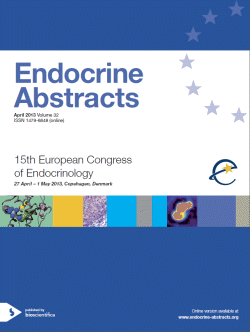Poster Presentations
Pituitary–Basic (<emphasis role="italic">Generously supported by IPSEN</emphasis>)
ea0032p823 | Pituitary–Basic (<emphasis role="italic">Generously supported by IPSEN</emphasis>) | ECE2013
Gene expression profiling of familial and sporadic pituitary adenomas
Barry Sayka , Gadaleta Emanuela , Chelala Claude , Korbonits Marta
ea0032p824 | Pituitary–Basic (<emphasis role="italic">Generously supported by IPSEN</emphasis>) | ECE2013
Role of filamin-A in the regulation of SST2 receptor localization and signalling in tumoral GH-secreting cells
Giardino Elena , Peverelli Erika , Vitali Eleonora , Cambiaghi Valeria , Lania Andrea G , Peccoz Paolo Beck , Mantovani Giovanna , Spada Anna
ea0032p825 | Pituitary–Basic (<emphasis role="italic">Generously supported by IPSEN</emphasis>) | ECE2013
Drosophila melanogaster as a model organism to study aryl hydrocarbon receptor interacting protein gene function
Aflorei Elena Daniela , Chen Chenghao , Klapholz Benjamin , Grossman Ashley B , Tapon Nicolas , Brown Nicholas H , Stanewsky Ralf , Korbonits Marta
ea0032p826 | Pituitary–Basic (<emphasis role="italic">Generously supported by IPSEN</emphasis>) | ECE2013
The role of GLI1 in pituitary tumor formation and pituitary cell survival
Lampichler Katharina , Ferrer Patricio , Vila Greisa , Luger Anton , Knosp Engelbert , Wagner Ludwig , Baumgartner-Parzer Sabina
ea0032p827 | Pituitary–Basic (<emphasis role="italic">Generously supported by IPSEN</emphasis>) | ECE2013
cAMP exerts proliferative and anti-proliferative effects in pituitary cells of different types by activating both cAMP-dependent protein kinase A and exchange proteins directly activated by cAMP
Vitali Eleonora , Peverelli Erika , Mantovani Giovanna , Giardino Elena , Lania Andrea G. , Beck-Peccoz Paolo , Spada Anna
ea0032p828 | Pituitary–Basic (<emphasis role="italic">Generously supported by IPSEN</emphasis>) | ECE2013
Expression of somatostatin receptors, SSTR2A and SSTR5, in 108 pituitary adenomas, using immunohistochemical detection with specific MABs
Chinezu Laura , Vasiljevic Alexandre , Jouanneau Emmanuel , Francois Patrick , Borda Angela , Raverot Gerald , Trouillas Jacqueline
ea0032p829 | Pituitary–Basic (<emphasis role="italic">Generously supported by IPSEN</emphasis>) | ECE2013
mTOR mediated IGF1 proliferative effects on a rat pituitary GH/PRL secreting pituitary adenoma cell line
Bellio Mariaenrica , Mirabassi Cecilia , Gagliano Teresa , Uberti Ettoredegli , Chiara Zatelli Maria
ea0032p830 | Pituitary–Basic (<emphasis role="italic">Generously supported by IPSEN</emphasis>) | ECE2013
Mutations of SOX2 gene: a novel heterozygous mutation and impact on congenital hypopituitarism
Auriemma Renata S , Macchiaroli Annamaria , Kelberman Daniel , Faienza Maria F , Corona Rosalia , Mariano Iolanda , Giangiobbe Sara , Galdiero Mariano , Pivonello Rosario , Colao Annamaria , Gasperi Maurizio
ea0032p831 | Pituitary–Basic (<emphasis role="italic">Generously supported by IPSEN</emphasis>) | ECE2013
Chracterizazion of somatostatin receptor expression in MENX-assoxciated pituitary adenomas: impact on therapy and imaging with somatostatin analogs
Lee Misu , Lupp Amelie , Gartner Florian , Castano Justo P , Schulz Stephan , Pellegata Natalia
ea0032p832 | Pituitary–Basic (<emphasis role="italic">Generously supported by IPSEN</emphasis>) | ECE2013
Clinical and morphological characteristics of dopamine agonist-resistant prolactinomas
Fedorova Natalia , Dzeranova Larisa , Pigarova Ekaterina , Abrosimov Alexander , Astaf'eva Liudmila , Rozhinskaya Liudmila
ea0032p833 | Pituitary–Basic (<emphasis role="italic">Generously supported by IPSEN</emphasis>) | ECE2013
Expression of connexins 26, 32 and 43 mRNA in normal and pituitary adenomas
Nunes Bruno , dos Santos Faria Manuel , Fortunato Rodrigo , Eurico Nasciutti Luiz , Renner Urlich , Stalla Gunter K. , de Carvalho Denise Pires , Miranda-Alves Leandro
ea0032p834 | Pituitary–Basic (<emphasis role="italic">Generously supported by IPSEN</emphasis>) | ECE2013
No correlation between somatostatine 2 receptor expression analyzed by RNA in-situ hybridization and real-time qRT-PCR in clinically non-functioning pituitary adenomas
Gabalec Filip , Kohout Ales , Laco Jan , Drastikova Monika , Beranek Martin , Netuka David , Masopust Vaclav , Cesak Tomas , Cap Jan
ea0032p835 | Pituitary–Basic (<emphasis role="italic">Generously supported by IPSEN</emphasis>) | ECE2013
FSH and LH cells in normal-fed male rats after centrally applied ghrelin
Milosevic Verica , Ajdzanovic Vladimir , Nesic Dejan , Starcevic Vesna , Ristic Natasa , Rakocevic Rastko , Stevanovic Darko
ea0032p836 | Pituitary–Basic (<emphasis role="italic">Generously supported by IPSEN</emphasis>) | ECE2013
PTTG and Ki-67 expression in pituitary adenomas
Golkowski Filip , Sokolowski Grzegorz , Wierzbicka-Tutka Iga , Baldys-Waligorska Agata , Adamek Dariusz , Hubalewska-Dydejczyk Alicja
ea0032p837 | Pituitary–Basic (<emphasis role="italic">Generously supported by IPSEN</emphasis>) | ECE2013
Medical therapy of acromegaly
Palha Ana , Cortez Luisa , Sabino Teresa , Silva Nunes Jose , Afonso Antonio , Fonseca Fernando , Agapito Ana
ea0032p838 | Pituitary–Basic (<emphasis role="italic">Generously supported by IPSEN</emphasis>) | ECE2013
Daidzein affects the stereological parameters of pituitary GH cell in orchidectomized adult rat
Trifunovic Svetlana , Ajdzanovic Vladimir , Filipovic Branko , Miler Marko , Ristic Natasa , Medigovic Ivana , Milosevic Verica
ea0032p839 | Pituitary–Basic (<emphasis role="italic">Generously supported by IPSEN</emphasis>) | ECE2013
8-Prenylnaringenin decreases hormone expression in GH3 pituitary adenoma cells of the rat
Rupa Rosita , Voellger Benjamin , Kirches Elmar , Mawrin Christian , Firsching Raimund




